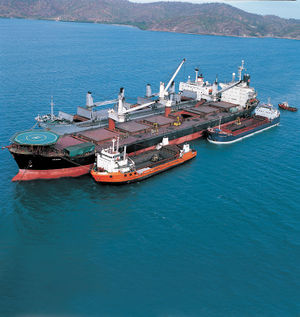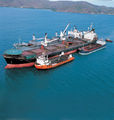Erawan II
Contents
History
1982. Delivered as "Yamashiro Maru" to Yamashita-Shinnihon.
1990. Renamed "Starfest"
1995. Owned by Hadley Shipping Co., renamed "Camarina"
1999. Bought by CNCo. renamed "Erawan" II. The vessel was upgraded for her new role being equipped with the following, a helideck:- 3 x 30 ton heavy duty articulated grab cranes with sophisticated weighing equipment and stainless steel grabs, upgraded mooring systems and coating systems, two addtional electrical generators, a high capacity desalination plant, fuel transfer systems and additional accommodation.
March 2000. Converted to a transhipment/silo vessel by the Wenchow Shipyard, China. New dimensions as per image.
April 2013. Work ceased at OK Tedi Mine. Vessel departed and arrived at Jiangmen ship-breaking yard on May 8th. Removed from Isle of Man register on May 12th.
Service
In 1989, Probo Baro, CNCo’s newly-built Product Oil Bulk Ore tanker, jointly owned with Klaveness, was chartered by the latter’s Bulkhandling group, to temporarily replace their bulk carrier Banta, which had been on charter to Ok Tedi Mining Limited in Papua New Guinea as a transhipment and silo ship for cargoes of copper concentrate. The Ok Tedi project involves the mining of gold and copper at Mount Fubilan, high in the Star Mountains in PNG’s Western Province and is something of a logistical nightmare, since the main route for supplies – and for the mine’s product – is via the shallow Fly River from the town of Kiunga, the nearest port to the mine, 750km inland. In 1982, Swire’s PNG associate (now a subsidiary), Steamships Trading Company (STC), had been awarded a contract for this service and personnel from China Navigation and sister company Swire Pacific Offshore were regularly deployed to STC’s vessels, so there was a high degree of synergy. Probo Baro successfully filled
the transloader role, stationed at the mouth of the Fly River, for one year and was to be the precursor to CNCo securing a longer-term contract from Ok Tedi.
In 1999, CNCo acquired the Japanese-built 64,000dwt Panamax bulk carrier "Camerina" – then 18 years old – and successfully tendered for the role of Ok Tedi’s “mother ship”. The bulker was duly brought up to CNCo standards and equipped with a heli-deck, three 30-ton heavy-duty, articulated grab cranes, sophisticated weighing equipment (designed to meet an extremely tight contractual accuracy of 0.5%) and special stainless steel grabs. Other equipment installed included two extra generators, a high-capacity evaporator (desalination plant), fuel transfer systems and extra accommodation, as well as upgraded mooring and coating systems. Erawan, as she now became, went on charter in April 2000. She operated on a seasonal pattern, with six months at the mouth of the Fly River, December to May, relocating to Port Moresby Harbour at the start of the monsoon season. Erawan's contract with Ok Tedi expired in 2013 and she departed Port Moresby in April of that year to be scrapped.
Copper concentrate exports contribute very significantly to the Papua New Guinean economy, and when fully laden, Erawan carried a cargo worth approximately US$450 million, with an annual throughput valued at US$5.6 billion.
Events / Stories
The little orange ship on the port bow looks like the OBO CHIEF.


